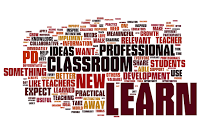The Big Four


Mix IT Up
There was a time when I would focus my discussions with others on how important infrastructure is when planning any type of technology integration project. My opinion on the importance of infrastructure has not changed over the years, however the conversation about the other ingredients that must go into the foundation for integrating technology in our classrooms are not independent of the infrastructure. As relevant as it is to have a robust network backbone and a great Internet connection, that by itself will not give our students the opportunities they need to be successful when they leave the K-12 environment.
Creating the right mix that goes into the foundation for integrating technology in our classrooms is similar to the science of creating the perfect batch of concrete that supports our houses, buildings and roads. The science used to arrive at the finished product is far more complicated than buying a few bags of concrete at your local Home Depot for the backyard swing set. Building a foundation for today's digital learners is as important as the base for the tallest skyscraper, and requires the proper mix of four key ingredients that I believe are critical for our classrooms. Let's take a look at the ingredients in no particular order.

Professional Development
Historically PD is the afterthought when integrating technology in our classrooms and becomes the first reason cited for technology integration failure. The excitement of having support to integrate the devices often allows a structured PD plan to be pushed aside, making it difficult to play catch up. If our foundation is going to hold up, we need our technology and curriculum departments working collaboratively with our site leaders, teachers, students, and parents to craft a PD plan. One way to accomplish a baseline for building a plan across all stakeholder groups is to leverage data. Participating in a survey, such as Project Tomorrow's Speakup Survey, allows educators, students, and parents to have feedback on their current and future technology use in education. The data provides starting points for discussions during the PD planning process and gives voice to all stakeholders involved.
Digital Citizenship
Digital citizenship is not different from the general definition of citizenship other than the medium where that community exists. If we expect our students to be responsible members of the digital community, then we have to collaborate with all stakeholders to create successful learning opportunities, have parental support, lead by example, and include our students in that discussion. A digital citizenship road map is a key ingredient to our foundation and one that will lead to many cracks if ignored. Having the proper resources and embedding digital citizenship within the everyday curriculum will allow teachable moments while not adding another layer and demonstrating real world application. Develop or adopt digital citizenship standards or elements that can be made visible throughout your school district and community. Providing a common digital citizenship language for all students, educators, and parents will help in changing the culture and support behavior in the digital world.
Devices
The million dollar question has long been, which device is the best choice for our classrooms. The simple answer is there is not a "best" choice or one size fits all device that exists, and the reason for that is simple in my opinion. Every classroom, school, and district is a little bit different than the next, the magic is finding the device that works best for you. There are a few ways to gather feedback from stakeholders that may take a bit of time, but will provide valuable feedback before making a commitment.

- Try and buy. If you are committed to purchasing devices, there will large amounts of budget spent, why not purchase a small number of devices first and distribute those to teachers, students, and technology staff. It is amazing how fast word spreads among teachers and students when they have a new device that allows them to improve what they are doing in the classroom.
- Student devices. Once a decision is made, allow your teachers to have access to a device prior to them being implemented in the classroom. Our teachers need to know the device before there are 30 of them in their classroom.
- Plan to manage. The technology team needs to understand the devices and be able to craft their plan on how they will manage devices in their network environment. Every device type will have it's own characteristics and the tech team will need to be able to support them in the classroom.
Remember that devices can be the most difficult ingredient in the foundation and cause the biggest cracks if not well thought out. Buy in from all stakeholders is important so that everyone is supportive of the device through its lifespan.
Infrastructure
Watching the discussion relating to infrastructure change with the transition from desktops to mobile devices has been exciting. The good old days of deciding where to locate the 5-8 drops per classroom now revolves around supporting a 1:1 environment and wireless connectivity from the front office to the football field. The challenge becomes where to begin when planning your infrastructure needs and how to build for the future. Taking the time to properly plan, it is much easier than chasing connectivity and bandwidth down the road, here are a few things to think about.
Tools and ideas to transform education. Sign up below.
- Take a field trip. Don't underestimate how much can be learned by visiting other districts, asking questions about their planning process and why they made the decisions that they did. Having prior knoweldge and learning from others before starting your journey is invaluable.
- Schools and Libraries Program (E-rate). The e-rate program was established in 1996 to assist schools and libraries with making their telecommunication needs more affordable. The program has gone through a modernization effort and is focused on assisting schools with obtaining affordable access to high-speed broadband and funding internal connections to support the connectivity. Participating in the program can make a difference in the planning process.
- Use the resources available for baseline data. There are national resources available such as Education Superhighway, who's mission is to bring internet access to every public classroom in our country. They have spent time putting together tool kits to help with the infrastructure planning process. Their resources were put together by working with districts from across our country and provide starting points.
- Outside assistance. Reaching out and working with experts in the infrastructure field is not a sign of weakness, it's a smart move. Bringing a consultant to the table is not only beneficial for collaborating on designing the appropriate infrastructure but offers large amounts of knowledge transfer throughout the process.
How to Finish
The last stage of pouring concrete is known as finishing and like many aspects of construction is a form of art. A good finisher brings that smooth, consistent look to the end product, that makes the weekend construction warrior so envious of. Finishing can also be considered the last step in tying together the ingredients of a strong foundation. Building an environment for today's digital learners is challenging, strenuous at times, and absolutely rewarding when student and teachers have a great experience integrating technology in the classroom. Remember, it's the ingredients working together that is supporting the foundation of your structure.
cross posted at jcastelhanothisandthat.blogspot.com
Jon Castelhano is director of technology for Apache Junction USD in Arizona and serves as an advisor to the School CIO member community, a group of top tier IT professionals in schools across the country who understand and benefit from news and information not available elsewhere. Read more at jcastelhanothisandthat.blogspot.com
